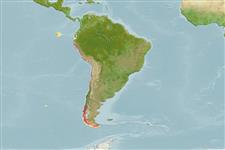Patiria chilensis Verrill, 1870
Chilean bat star| Native range | All suitable habitat | Point map | Year 2050 |

|
| This map was computer-generated and has not yet been reviewed. |
| Patiria chilensis AquaMaps Data sources: GBIF OBIS |
Upload your photos
Google image |
No photo available for this species.No drawings available for Asterinidae.
Google image |
No photo available for this species.
Classification / Names Common names | Synonyms | CoL | ITIS | WoRMS
Asteroidea | Valvatida | Asterinidae
Environment: milieu / climate zone / depth range / distribution range Ecology
Benthic; depth range 0 - 20 m (Ref. 87801). Subtropical
Distribution Countries | FAO areas | Ecosystems | Occurrences | Introductions
Southeast Pacific: Chile and Peru.
Length at first maturity / Size / Weight / Age
Maturity: Lm ? range ? - ? cm
This is an epibiotic species found on hard bottoms and holdfasts of Lessonia nigrescens in intertidal areas to 20 meters in depth. It feeds on mollusks and detritus (Ref. 87801).
Life cycle and mating behavior Maturity | Reproduction | Spawning | Eggs | Fecundity | Larvae
It has 1 annual reproductive cycle. Gametes form at the beginning of summer for males and in winter for females. Spawning occurs during spring. Planktotrophic development (Ref. 87801).
Main reference
References | Coordinator | Collaborators
Häussermann, V. and G. Försterra. 2009. (Ref. 87801)
IUCN Red List Status (Ref. 130435)
CITES status (Ref. 108899)
Not Evaluated
CMS (Ref. 116361)
Not Evaluated
Threat to humans
Harmless
Human uses
| FishSource |
Tools
More information
Internet sources
BHL | BOLD Systems | CISTI | DiscoverLife | FAO(Publication : search) | Fishipedia | GenBank (genome, nucleotide) | GloBI | Gomexsi | Google Books | Google Scholar | Google | PubMed | Tree of Life | Wikipedia (Go, Search) | Zoological Record
Estimates based on models
Preferred temperature
(Ref. 115969): 12.5 - 23.4, mean 19.9 (based on 70 cells).


